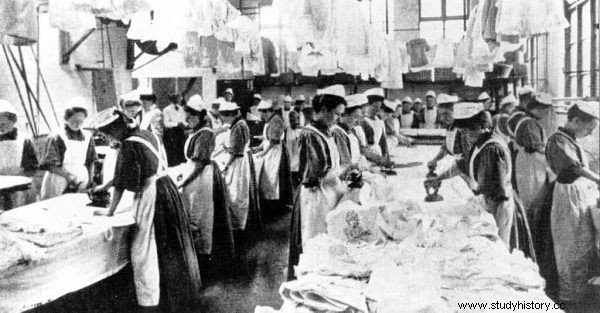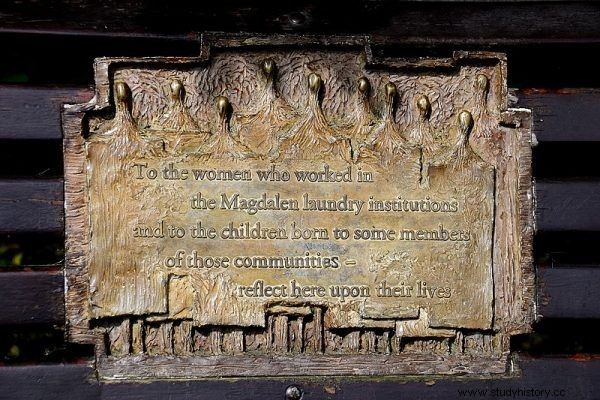In 1993, a Dublin order sold the land to a developer. In addition to the grounds, an assembly inadvertently released a secret that shocked the public. During construction, a collective grave of 155 female bodies was found. The anonymous tomb was just the first of many macabre secrets of an institution that was supposed to help the "lost" ...
In the tradition of the Roman Catholic Church, Mary Magdalene is presented as a fallen woman who, after meeting Jesus and listening to his words, became one of his most zealous disciples. This image raises a lot of controversy to this day, but the most terrifying thing is that it also became a cover for the crime.
The history of the saint made her the patron saint of the Congregation of the Sisters of St. Mary Magdalene of Penance. It was founded in the thirteenth century, and its motto was to turn "misguided" ladies from the path of sin. The means to the end - at least officially - were prayer, silence, work, fasting, and all kinds of mortification.
In the mid-nineteenth century, many Magdalene's asylum seekers were established in Great Britain and Ireland. Initially, they functioned as temporary shelters for prostitutes, single mothers and women affected by domestic violence. Those in need could voluntarily take refuge behind the walls to rest and get a chance for a new beginning. They often returned to their religious homes, because only there could they hide from the cruel outside world.
Unfortunately, the lofty idea behind the asylum seekers soon turned them into prisons where women, and even little girls, were placed under duress. Often death was the only option.
Magdalenek laundries
The Magdalenki refuges left a special mark on the Irish women. When their country regained its independence at the beginning of the 1920s, the Catholic Church took over the care of the nursing homes, which, in the opinion of the residents, was supposed to worsen the living and working conditions.
Worse, soon women began arriving at facilities for reasons other than searching for a chance to catch a breath and bounce off the bottom. Apart from prostitutes and pregnant maids, there were also girls who were mentally ill or had problems with the law:
26 percent of all women detained in asylum throughout Ireland were admitted there at the request of state institutions, 10 percent on the initiative of families, the rest were led by priests or carers from orphanages.

In Magdalenki laundries, women were forced to work beyond their strength.
To be sent under the wing of nuns could also be "earned" by ... being too pretty and flirting with boys. Many of the female penitents were barely girls who had not yet entered puberty well, and had already become an unnecessary burden for caregivers.
In the eyes of the outside world, the refuges were nursing homes, offering shelter and the opportunity to work - usually in laundries, hence these places were also called Magdalenki laundries. But what actually happened behind closed doors was a closely guarded secret. Even those women who managed to survive the hell that had been prepared for them were afraid to tell about it.
Hell's Sanctuaries
After being locked in the asylum, the penitents had their names changed and all rights deprived. Their hair was often cut close to the skin. Sisters, friends, relatives - women who had a close relationship were immediately separated and sent to various institutions.
Bars on the windows, strong locks on the doors, high walls often topped with barbed wire and no contact with the outside world. These orders were more like prisons than places of repentance and reconciliation with God.
Work in the laundry was supposed to be a metaphor for cleansing the body and soul, but the conditions of its performance led to exhaustion rather than revelation. Women worked 6 days a week for 10 hours without any, even minimum wages. In addition, they were bound by the rule of silence, and any signs of disobedience were severely punished physically and mentally. Beating with leather belts, undressing naked and making fun of appearance - these are just a few of the penalties cited by former residents of "help" houses.
Maidens who went to madeleines with an illegitimate pregnancy usually waited for separation from the newborn child, in many cases against the will of the mother. It broke the psyche of women. In addition, some of them have experienced sexual abuse by priests staying in their orders.

Plaque commemorating the penitents of Magdalenki asylum.
There was little chance of leaving this hell. Female penitents were allowed to leave only at the request of a family member - usually a father, brother or other male relative. The inability to communicate with the outside world and being cut off from the reality known to them meant that many of them lived their last days in the convents, remaining anonymous both to other prisoners and to the world.
Regret for sins
The last of the Magdalenki asylum was closed in 1996. The event eventually prompted three former residents - Mary Norris, Josephine McCarthy and Mary-Jo McDonagh - to reveal the truth about life among the nuns. The stories from the Magdalenki laundry touched the world deeply. On their basis, several documents were created, as well as two feature films:"Magdalene Sisters" and "The Secret of Philomena" starring Judi Dench in the lead role.
Despite the lack of official data, it is estimated that about 30,000 women went through the asylum. Most of them will remain anonymous.
In February 2013, the Prime Minister of Ireland, Enda Kenny, officially called the laundries a "national disgrace" and apologized to all former female penitents for the tragedies they experienced.
